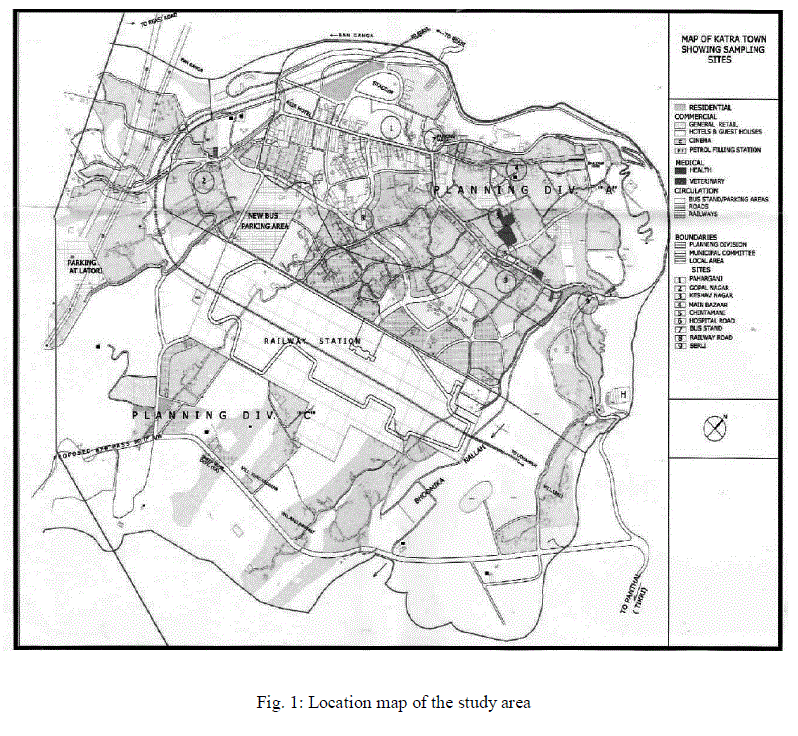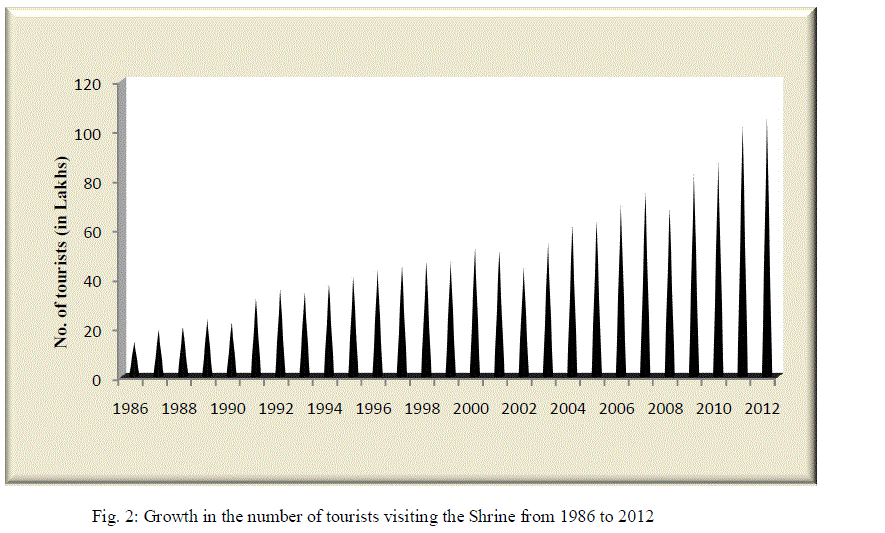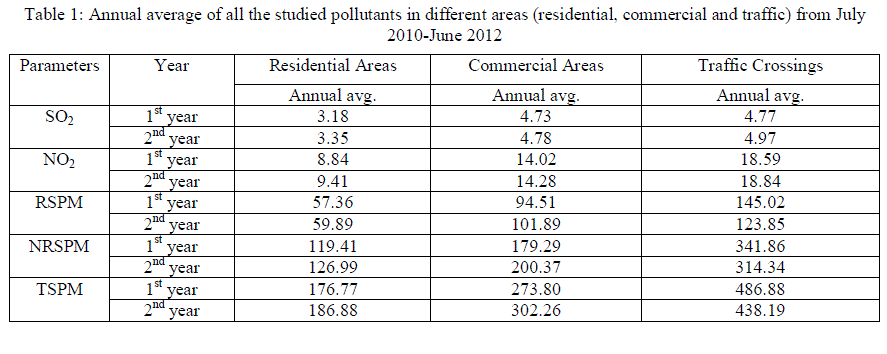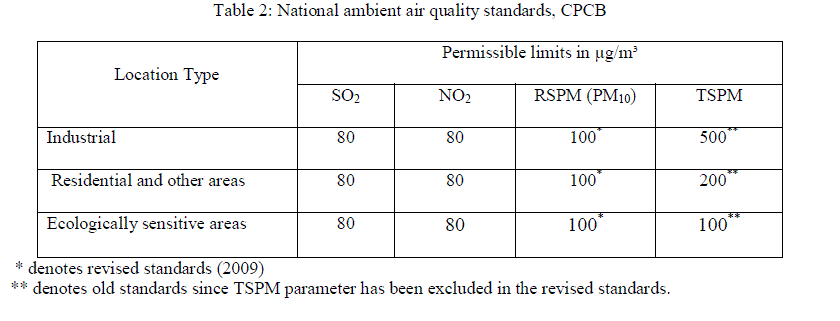ISSN ONLINE(2319-8753)PRINT(2347-6710)
ISSN ONLINE(2319-8753)PRINT(2347-6710)
Anita Sharma1 and Anil. K. Raina2
|
| Related article at Pubmed, Scholar Google |
Visit for more related articles at International Journal of Innovative Research in Science, Engineering and Technology
Tourism is one of the biggest and fastest growing sectors in the global economy and has significant environmental, cultural, social and economic effects, both positive and negative. Tourism affects the environment of an area either directly or indirectly. The quality of the environment, both natural and man-made, is essential to tourism. But tourism, if unplanned and unregulated can be extremely harmful to the environment because tourism and environment have a very complex and interdependent relationship. In the state of Jammu and Kashmir also, tourism is the largest retail industry. Pilgrimage tourism to Katra town constitutes an important component of total tourism in J&K and has contributed significantly to the growth and development of Katra town, base camp of Shri Mata Vaishno Devi Shrine. The number of tourists/pilgrims to the Shrine is increasing with each passing year. Presently, 30,000- 35,000 pilgrims visit the town every day, on an average. But this increasing number of tourist is directly or indirectly influencing the environment of the town. It has put enormous pressures and lead to impacts such as soil erosion, increased pollution, waste generation, natural habitat loss and strains on water resources. Many of these impacts are linked with the construction of general infrastructure such as roads and airports and of tourism facilities, including resorts, hotels, restaurants, shops etc. Therefore, the present paper aims to highlight the possible environmental impacts arising from the construction and further development of facilities for tourism and associated activities and to describe measures to avoid or minimise damage to the environment.
Keywords |
| Tourism, Environmental impacts, Sustainability, Katra |
INTRODUCTION |
| Tourism is considered to be an important vehicle for economic and social development. The tourism industry has significant environmental, cultural, social and economic effects, both positive and negative. Tourism can be a major tool for economic development but, if not properly planned it can have destructive effects on biodiversity and pristine environments and can result in the misuse of natural resources such as freshwater, forests and marine life [1]. Negative impacts from tourism occur when the level of visitor use is greater than the environment's ability to cope with this use within acceptable limits of change. Uncontrolled conventional tourism poses potential threats to many natural areas around the world. It can put enormous pressure on an area and lead to impacts such as soil erosion, increased pollution, discharges into the sea, natural habitat loss, increased pressure on endangered species and heightened vulnerability to forest fires. It often puts a strain on water resources and it can force local populations to compete for the use of critical resources. The permanent alteration of the environment in a target tourist destination causes stresses in the surrounding area. The clearing of existing vegetation or levelling of the terrain for the construction or expansion of such things as airport, roads, theme parks or hotels has a major impact on the environment. Air pollution level is increased with the emissions coming from vehicles, airplanes and generators. Noise pollution from airplanes and other vehicles also increases. Other factors such as waste, littering and sewerage may also aggravate the problem. |
| Pilgrimage traffic has a widespread reach in India from the North to the South to centres in Vaishno Devi, Rishikesh, Haridwar, Prayag, Badri-Kedar to Rameshwaram, Tirupati and from the West to the East viz. Amba Devi and Kamakhya Devi, just to name a few [2]. The Holy Shrine of Shri Mata Vaishno Devi attracts lakhs of devotees owing to the unflinching faith of the people who throng the Shrine from all parts of India and abroad. Katra, a small but vibrant town, situated around 48 kilometers from Jammu, (the winter capital of the State of Jammu & Kashmir), serves as the base camp for the journey to the Shrine. |
RELATED WORK |
| Survey of the literature revealed that several studies on the related work have been carried out by various researchers in the world ([1, 3 and 4]) and in India also ([5, 6, 7 and 8]), to highlight the impact of tourism on environment of a particular area and also on sustainable tourism. In Jammu and Kashmir (J&K), very few studies have been carried out to assess the impact of tourism on environment [9]. In all these studies, the researchers concluded that tourism has several harmful effects on the various aspects of environment such as air, water, soil, forests, wildlife marine life etc. Tourism industry absolutely affects the environment. Its negative impact is very dangerous for the environment and the future generation. They also recommended several measures through which tourism can be planned in such a way that its harmful effects can be reduced to a certain extent, for instance, controls on the number of tourist activities and movement of visitors within protected areas can limit impacts on the ecosystem and help maintain the integrity and vitality of the site. Such limits can also reduce the negative impacts on resources. For this reason planning and sustainable tourism industry is very essential for every country. |
STUDY AREA |
| Pilgrimage tourism to Shri Mata Vaishno Devi Shrine constitutes an important component of total tourism in J&K and has contributed to the growth of development of its base camp i.e. Katra town. Every year millions of people visit the Shrine and the volume of pilgrims to the Shrine is increasing with each passing year but so far no systematic study has been carried out in Katra town which is one of the important town of Jammu from economic as well as religious point of view and where construction and demolition for providing better infrastructure to tourists is a growing trend. For development works, we need to cut mountains and fell a large number of trees - which is bound to disturb the ecological balance in the hilly area. Also, the number of vehicles along with other sources of pollution is constantly increasing because of continuous increase in the number of tourists. |
| Katra (latitude 32059 N, longitude 74055 E and average altitude 2840 feet above the mean sea level) is the most important town from economic as well as religious point of view. It is situated at the foothills of the Trikuta mountains (a part of the Sub-Himalayan Shivalik range), in the Reasi district of J&K state about 48 km away from Jammu city and has a thriving tourism industry that offers plenty of hotels, guest houses, restaurants, dhabas, fast-food joints etc. (Fig. 1). The town witnesses the influx of thousands of pilgrims everyday to the tune of ten million people annually. The number of pilgrims visiting the Shrine has risen from 1.4 million in 1986 to 10 million in 2012 (Fig. 2). But this increasing number of tourists has directly or indirectly impacted the environment of the area i.e. Katra town. Brisk developmental activities from Katra to the cave Shrine have been posing an ecological threat to the Trikuta hills and the biggest challenge is to maintain ecological balance. Spatial pattern of the town consists of congested 2-4 storied houses closely knit and approachable by narrow lanes. The town has virtually turned into a concrete jungle at the cost of its serenity and environment as haphazard expansion is going on to cater the needs of tourists. |
 |
 |
MATERIAL AND METHODS |
| In the present study, an attempt has been made to assess the impact of tourism (on the basis of primary data and secondary information) on various aspects of the environment of the holy town Katra i.e. air quality, water quality and waste generation. |
| For the collection of data on air quality, air sampling was carried out at nine sites (3 residential, 3 commercial and 3 traffic crossings) for two years, on monthly basis, from July 2010 to June 2012, during daytime, for a period of 8 hours and analyzed for the parameters viz., SO₂, NO₂, RSPM and NRSPM, by using the Envirotech High Volume Respirable Dust Sampler APM 460 BL designed for particulate matter and simultaneously, for sampling of gaseous pollutants by attaching a gaseous sampling attachment APM 411. |
| Sulphur dioxide (SO2) in the air has been analysed by using Modified West and Gaeke Method IS 5182, part II [10]; Nitrogen dioxide (NO2) has been analysed by Jacob and Hochheiser method IS 5182, part VI [11] while the particulate matter (RSPM and NRSPM) has been analysed by using Gravimetric method, IS 5182, part IV [12]. |
| Data on solid waste generation and its disposal has been collected through unstructured interviews with shop owners, hotel staff, local community and local authorities as well as through surveys and personal observation. |
RESULTS AND DISCUSSION |
AIR QUALITY |
| The annual average concentration of all the studied pollutants for the two years has been depicted in table 1. The perusal of the table revealed that the concentration of all the studied parameters has been observed to be higher at the traffic crossings followed by commercial areas, thus clearly indicating the impact of vehicular traffic on ambient air quality. Further, it has been observed that concentration of pollutants has increased during peak tourist activity resulting in increase in vehicular traffic, increased burning of fossil fuels for cooking and heating in hotels, restaurants etc. The increased concentration of air pollutants during peak tourist activity has also been pointed out by [5]. The recorded data revealed that the particulates (both RSPM and NRSPM) are the major pollutants in the town and are of concern since they have been recorded higher than the prescribed limits at most of the sites. Higher concentrations of particulates may be attributed to the construction of general infrastructure such as roads and airports, and of tourism facilities, including resorts, hotels, restaurants, shops etc. The average concentration of gaseous pollutants i.e. SO2 and NO2 has been observed to be well within the NAAQS limits as stipulated by CPCB, at all the sites (Table 2). |
 |
WATER QUALITY |
| Like air quality, impact of tourism has also been observed on water quality (Ban Ganga River) of the town in various researches conducted. Ban Ganga is a shallow stream originating from snow-bound hills of Shri Mata Vaishno Devi Shrine and is the main source of water supply to the inhabitants of Katra town and its suburbs. Ban Ganga is being used as a garbage dump by pony/horse owners, restaurant/hotel owners, community kitchens, army camp and above all untreated sewage from whole of Katra town with increased load than the carrying capacity of the hill town because of heavy tourist influx. |
| An increase in pollutant concentration in downstream (as soon as it passes from Charan Paduka and at the bathing ghat below bridge) in comparison to upstream has been observed [6]. Hence it is an alarming position of increasing pollution load in the river. |
SOLID WASTE GENERATION |
| In areas with high concentrations of tourist activities and appealing natural attractions, waste disposal is a serious problem and improper disposal can be a major despoiler of the natural environment, rivers, scenic areas and roadsides. Similarly, in Katra town also, solid waste is a serious problem and is creating unhygienic conditions in air and water environment. As observed from the personal interviews, households disposes generated solid waste near to their house, round the corner, in open plots, on roads, in open drains or burnt it out. Even restaurants, small dhabas, roadside vendors throw their waste on road, as observed during primary survey. There is an absence of waste collection dustbins along major roads and sub-lanes. Total solid waste generation in the town has been shown in table 3. The estimated solid waste generation in the town is 17.4 tons/day. The data on mule dung generation has been collected from the office of the municipality. |
 |
CONCLUSION AND RECOMMENDATIONS |
| From the study, it can be concluded that tourist activities has impacted the environment of Katra town in several ways. Ambient air quality has been found to be affected because of the increase in the number of vehicles due to increased tourist activity, water quality of the main river of the town has also shown changes in physico-chemical characteristics due to bathing and washing activities of the tourist as well as a lot of waste is being generated which is creating unhygienic conditions in the town. |
| To avoid these impacts, tourism need to be planned, managed and undertaken in a way that is environmentally sustainable, socially beneficial and economically viable. In order to provide sustainability in tourism, it is necessary to know environmental, social and economic impacts of tourism activities and to consider these effects, during the planning. A systematic development plan/physical plan should be made, considering the town’s future growth and other development. The way development/expansion of Katra is taking place; planning needs to be done. Building regulations should be applied in an effective manner in order to minimize the impact of construction on the natural environment of the town. Major state and districts roads which pass from the town, connecting Katra with other districts and states, are not in a good condition with respect to surface quality and width. So this aspect should be considered while planning in order to reduce congestion and traffic jams. |
| Tourism has the potential to increase public appreciation of the environment and to spread awareness of environmental problems when it brings people into closer contact with nature and the environment. This confrontation may heighten awareness of the value of nature and lead to environmentally conscious behaviour and activities to preserve the environment. |
References |
|